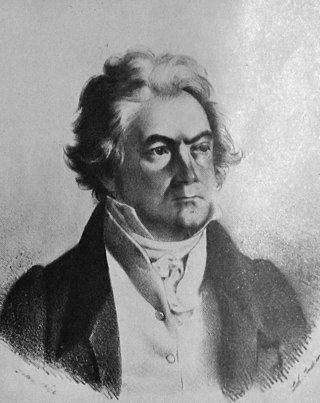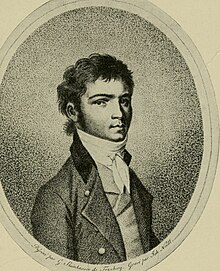
The Symphony No. 8 in F major, Op. 93 is a symphony in four movements composed by Ludwig van Beethoven in 1812. Beethoven fondly referred to it as "my little Symphony in F", distinguishing it from his Sixth Symphony, a longer work also in F.

The Piano Sonata No. 29 in B♭ major, Op. 106 by Ludwig van Beethoven was composed in 1817 and published in 1818. The sonata is widely viewed as one of the most important works of the composer's third period, a pivotal work between his third and late period, and among the greatest piano sonatas of all time. It is also considered to be Beethoven's most technically challenging piano composition and one of the most demanding solo works in the classical piano repertoire. The first documented public performance was in 1836 by Franz Liszt in the Salle Erard in Paris to an enthusiastic review by Hector Berlioz.

Ludwig van Beethoven composed his String Quartet No. 4 in C minor, Op. 18, No. 4, between 1798 and 1800 in Vienna and published in 1801. The Op. 18 collection is dedicated to Joseph Franz von Lobkowitz.

Ludwig van Beethoven's Piano Sonata No. 3 in C major, Op. 2, No. 3, was written in 1795 and dedicated to Joseph Haydn. It was published simultaneously with his first and second sonatas in 1796.
In music, the three-key exposition is a particular kind of exposition used in sonata form.

The String Quartet No. 15 in A minor, Op. 132, by Ludwig van Beethoven, was written in 1825, given its public premiere on November 6 of that year by the Schuppanzigh Quartet and was dedicated to Count Nikolai Galitzin, as were Opp. 127 and 130. The number traditionally assigned to it is based on the order of its publication; it is actually the thirteenth quartet in order of composition.

The Cello Sonata No. 1 in E minor, Op. 38, entitled "Sonate für Klavier und Violoncello", was written by Johannes Brahms in 1862–65.
The Piano Sonata No. 9 in E major, Op. 14, No. 1, is an early-period work by Ludwig van Beethoven, dedicated to Baroness Josefa von Braun, one of his patrons at that time. It was composed in 1798 and arranged for string quartet by the composer in 1801, the result containing more quartet-like passagework and in the more comfortable key of F major.
The Piano Sonata No. 18 in E♭ major, Op. 31, No. 3, is an 1802 sonata for solo piano by Ludwig van Beethoven. A third party gave the piece the nickname "The Hunt" due to one of its themes' resemblance to a horn call. Beethoven maintains a playful jocularity throughout much of the piece, but as in many of his early works, the jocular style can be heard as a facade, concealing profound ideas and depths of emotion.

The Piano Sonata No. 25 in G major, Op. 79, was composed by Ludwig van Beethoven in 1809. It is alternatively titled "Cuckoo" or "Sonatina," and it is notable for its shortness. A typical performance lasts only about nine minutes. The work is in three movements: a fast-paced Presto alla tedesca, a slower Andante, and a lively Vivace.

Ludwig van Beethoven's Piano Sonata No. 1 in F minor, Op. 2 No. 1, was written in 1795 and dedicated to Joseph Haydn. It was published simultaneously with his second and third piano sonatas in 1796.

Ludwig van Beethoven's Piano Sonata No. 2 in A major, Op. 2, No. 2, was written in 1795 and dedicated to Joseph Haydn. It was published simultaneously with his first and third sonatas in 1796.
Beethoven's Piano Sonata No. 11 in B♭ major, Op. 22, was composed in 1800, and published two years later. Beethoven regarded it as the best of his early sonatas, though some of its companions in the cycle have been at least as popular with the public.

The compositions of Ludwig van Beethoven in the key of C minor carry special significance for many listeners. His works in this key have been said to be powerful and emotive, evoking dark and stormy sentiments.

The Piano Sonata No. 28 in A major, Op. 101, by Ludwig van Beethoven was composed in 1816 and published in 1817. Dedicated to the pianist Baroness Dorothea Ertmann, née Graumen, it is considered the first of the composer's late piano sonatas.

Ludwig van Beethoven's Piano Sonata No. 22 in F major, Op. 54, was written in 1804. It is contemporary to the first sketches of the Symphony No. 5 in C Minor. It is one of Beethoven's lesser known sonatas, overshadowed by its widely known neighbours, the Waldstein and the Appassionata.
The six String Quartets, Op. 76, by Joseph Haydn were composed in 1797 or 1798 and dedicated to the Hungarian count Joseph Georg von Erdődy (1754–1824). They form the last complete set of string quartets that Haydn composed. At the time of the commission, Haydn was employed at the court of Prince Nicolaus Esterházy II and was composing the oratorio The Creation as well as Princess Maria Hermenegild Esterházy's annual mass.

The six string quartets Op. 20 by Joseph Haydn are among the works that earned Haydn the sobriquet "the father of the string quartet". The quartets are considered a milestone in the history of composition; in them, Haydn develops compositional techniques that were to define the medium for the next 200 years.

The String Quartets, Op. 50, were composed by Joseph Haydn in 1787. The set of six quartets was dedicated to King Frederick William II of Prussia. For this reason the set is commonly known as the Prussian Quartets. Haydn sold the set to the Viennese firm Artaria and, without Artaria's knowledge, to the English publisher William Forster. Forster published it as Haydn's Opus 44. Haydn's autograph manuscripts for Nos. 3 to 6 of the set were discovered in Melbourne, Australia, in 1982.















